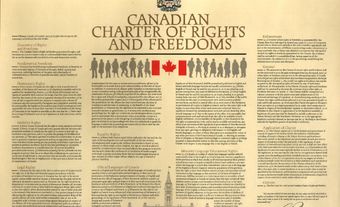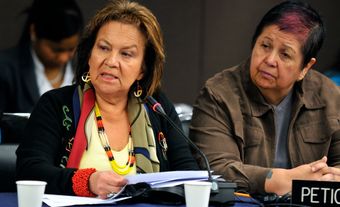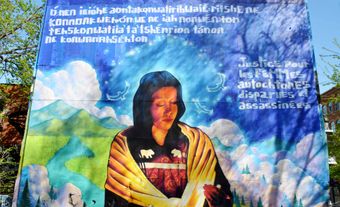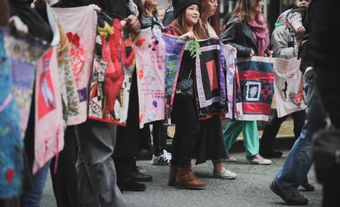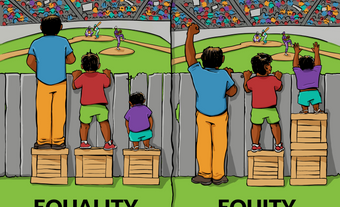Intersectionality is a feminist theory which analyzes various forms of oppression and hierarchies of power. In addition to gender, it takes into account a number of sociodemographic factors and examines how these factors may simultaneously interact. This theory highlights the power relationships which exist between various groups. It calls for reflection regarding the positions and privileges someone has where they live. The theory of intersectionality has aroused a great deal of interest and has led to debates which help advance analysis within feminist and social movements. (See Women’s Movements in Canada: 1985 - present; Indigenous Women’s Issues in Canada.)

Intersectionality: Definitions
The term “intersectionality” is used to describe the multiplicity and interconnectedness of various types of discrimination and how these relate to domination and oppression, i.e., the exploitation of one social group by another. Intersectional analysis calls for us to acknowledge our privileges, defined as unearned advantages resulting from one’s personal circumstances. While such analysis is not always easy, it is important to identify and understand both who we are and the privileges we have. and determine which characteristics represent either a privilege or an oppression in our environment.
The purpose of intersectionality is to understand how the intersections of various individual traits lead to specific experiences of oppression and privilege. The consequences of these characteristics are often experienced simultaneously, with each factor having a potential effect on the others. For example, in 2016 in Canada, the income of non-racialized white women was, on average, lower than that of white men (67 cents for every dollar earned by men). The gap was bigger in the case of racialized women (who earned, on average, 59 cents for every dollar earned by white men). An individual’s income can thus be affected by both their race and gender. (See also Income Distribution.)
Some intersectional feminists also adhere to the principle of giving equal weight to all oppressions, i.e., that the same approach must be taken regarding all existing oppressions. There is, however, no consensus in this regard among feminist theorists.
Origin of the Concept of Intersectionality
The roots of intersectionality lie in post-enslavement America. Thinkers like W.E.B. Du Bois (the first African American to receive a Ph.D. from Harvard University) discussed the complexity of domination systems using the example of the life experiences of African Americans. Other works (such as Women, Race and Class) paved the way for the development of the theory of intersectionality. Initially, the theory of intersectionality was intended to analyze the oppression of Black American women by taking a critical approach to white feminism. (See also Black Canadians.)
American jurist Kimberlé W. Crenshaw is the author most often cited as having defined the concept of intersectionality. In a text published in 1989, she analyzed several legal proceedings based on discrimination in the workplace in the United States. She demonstrated that the complaints of Black American women often fell on deaf ears, not only because of their gender, but because they were also discriminated against for being Black. Kimberlé W. Crenshaw was the first to introduce the concept of intersectionality to describe their complicated position. However, this is not the only way in which this theory (which is based on several schools of thought, in particular, Black feminism) was introduced.
Criticisms of Intersectionality
Shortly after the distribution of her founding texts, intersectionality became a key concept in Anglo-Saxon feminism. Intersectionality meshes well with identity politics — an approach which focuses on the occurrences of injustice experienced by various minority groups.
This theory has, however, been the subject of criticism. As it initially emerged to highlight the experience of Black American women, race implicitly be the most important aspect. Feminists from other contexts express reservations regarding this theory, viewing it as relating to the American reality and not necessarily having universal resonance.
The Marxist criticism of intersectionality focuses on the lack of a theory to help explain the origins of power relations and oppression. While intersectional analysis allows the identification of where the domination is occurring, it does not explain why it is occurring. Author Martha E. Gimenez rejected the principle that there is no hierarchy of oppressions. Rather, she contended that class is not equivalent to race and gender. According to her, some power relations are weightier and have more consequences than others.
Jasbir K. Puar, a theorist and Professor of Women’s and Gender Studies at Rutgers University, suggests shifting from the concept of intersectionality to that of assemblage, which. According to her, intersectionality has not been successful in removing white women from their predominant position in feminism and racialized women remain feminism’s “others.” Jasbir K. Puar challenges the idea that intersectional analysis can cross national and regional frontiers and be universally applied. When this issue is raised, she contends that, insofar as the privileged categories of intersectional analysis are the product of colonial agendas and specific violent regimes, the possibility exists that intersectionality’s journey outside its original framework is another way of imposing the theoretical models of the West on the rest of the world. (See also Imperialism.)
There are other issues involved in the application of intersectionality, such as the multitude of different terms used: intersections, intersecting systems of privileges and oppression, simultaneous oppressions, interconnected inequalities, etc. These many interpretations may create an impression of vagueness and ambiguity, but may also be seen as a strength.
Examples of Intersectional Approaches in Canada
A number of groups working in this field have included intersectionality in their toolboxes. For example, the Women’s Shelters Canada group has determined that the current mechanisms of response to violence against women and people of various genders have been unsuccessful in significantly reducing the levels of violence. (See Family Violence.) Moreover, the group has observed that those with the least access to services were subjected to the worst levels of violence. This is particularly true of women living in isolated and rural areas and Indigenous populations (see Missing and Murdered Indigenous Women and Girls in Canada). It is also true of people with a disability (see Ableism), as well as those who are racialized, Black (see Racism), gender nonconforming, trans (see Gender Identity), and migrants (see Irregular Immigration and Canada).
Another group, the Independent Learning Federation, asked six women to draw five comic strips portraying intersectional feminism. These comic strips illustrated the many types of discrimination that may be experienced, such as fatphobia, racism, transphobia, and sexism.
The Government of Canada has become involved in the development and implementation of intersectional public policies. This is particularly evident with Gender-Based Analysis Plus (GBA+). The process assesses the systemic inequalities and the possible effects of government policies on men and women from various backgrounds. The Centre for Gender, Diversity and Inclusion Statistics, a division of Statistics Canada, allows cross-sectional data to be produced for GBA+. While, as in most countries, the integration of intersectionality into Canadian policies is still in its early stages, GBA+ nonetheless represents a concrete example of its application.

 Share on Facebook
Share on Facebook Share on X
Share on X Share by Email
Share by Email Share on Google Classroom
Share on Google Classroom


